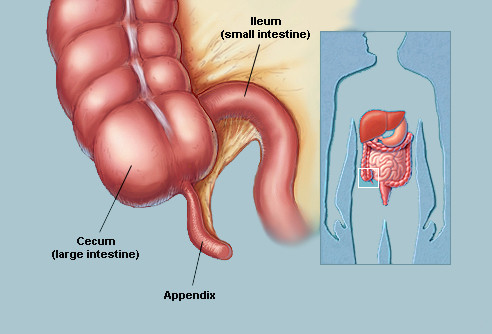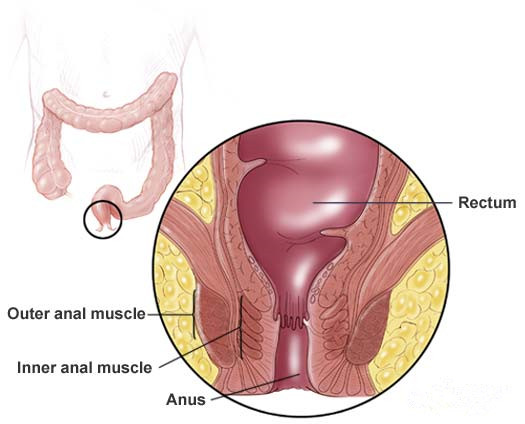The large intestine is the second section of the alimentary canal. The large intestines start in the pelvis at the right iliac region located immediately under the waist on the right-hand side. From here, the colon travels up the abdomen, then crosses horizontally at the top of the abdominal cavity, and finally turns downwards, to finish at the anus.
The large intestine absorbs water from any undigested food passing out of the small intestine, and allows the body to eliminate waste substances from food. Here we will try to figure out the parts of large intestines with specific functions.
What Are the Parts of the Large Intestine?
 1. Cecum
1. Cecum
This pouch-like section at the beginning of the large intestine is around two inches long. It absorbs digestive fluids passing out the ileum of the small intestine, and passes the waste material on to the colon.
2. Appendix
At the bottom of the cecum, there is a closed tube called the appendix or vermiform appendix. The appendix is a vestigial organ that has lost all or at least most of its original functions in humans through evolutionary processes. Therefore, whereas it was once useful in our ancestors, it's now just a small remnant.
3. Colon
 As one of the parts of the large intestine, the colon can be the main section of the large intestine. Sometimes, people use the word colon to refer to the whole large intestine. The majority of water absorption takes place here, and any salts required by the body are also absorbed. There are four parts to the colon:
As one of the parts of the large intestine, the colon can be the main section of the large intestine. Sometimes, people use the word colon to refer to the whole large intestine. The majority of water absorption takes place here, and any salts required by the body are also absorbed. There are four parts to the colon:
- Ascending colon: The ascending colon uses muscle contractions to push up any undigested food products from the cecum to the top of the abdominal cavity, just below the right bottom edge of the liver.
- Transverse colon: This second section of the colon transverses the anterior abdominal wall from the right to the left-hand side of the abdomen, immediately under the stomach.
- Descending colon: The food particles travel down the descending colon on the right-hand side of the abdomen, close to the spleen.
- Sigmoid colon: This is an S-shaped section at the end of the colon. It bends inwards towards the small intestine, before terminating in the rectum.
4. Rectum
 Around the end of the large intestine, the rectum is around 1-1.6 inches (2.5-4 cm) long. Residual waste accumulates in and stretches the rectum, until you feel the urge to go to the bathroom, and when you send the signal to defecate, the debris passes through the anus.
Around the end of the large intestine, the rectum is around 1-1.6 inches (2.5-4 cm) long. Residual waste accumulates in and stretches the rectum, until you feel the urge to go to the bathroom, and when you send the signal to defecate, the debris passes through the anus.
5. Anus
The rectum opens to the outside through the anus. Feces exit the anus through the contraction of sphincter muscles, in a process termed defecation.
To get a further understanding of the parts of the large intestine, have a look at the following video:
Common Disorders of the Large Intestine
1. Intestinal Gas
Excess gas inside the intestine can be painful and embarrassing. Most of it is swallowed air, but it also contains gases produced by bacteria fermenting undigested food, including carbon dioxide, hydrogen, and methane, and other compounds that give the gas its unpleasant smell. To decrease intestinal gas, slow down whilst eating, and limit certain foods, for example, beans, Brussels sprouts, curry, cabbage, onions, and cauliflower. Avoid milk if you're lactose-intolerant.
2. Diarrhea
Stool consistency is determined by the speed at which undigested food passes through the large intestine, and thus how much water can be absorbed. If the food travels too quickly through the intestine, not enough water is absorbed, resulting in diarrhea. Diarrhea can be caused by high-fiber diets, stress, poisoning, or infection. If there is infection or chemical irritation, the diarrhea can be protective, flushing harmful toxins from the body.
3. Constipation
Conversely, if food travels through the large intestine too slowly, too much water is absorbed, resulting in hard stools that are difficult to expel. Low fiber diets can cause this constipation by inhibiting fecal movement through the digestive system. Constipation can also be due to impaired sensory signaling from the rectum, or through consciously inhibiting defecation. To combat constipation, eat fiber-rich foods, drink plenty of water, and do regular exercise.
4. Irritable Bowel Syndrome
If the colon muscle is contracting too frequently, this may cause a condition known as irritable bowel syndrome (IBS). Patients with IBS may experience trapped wind, bloating, abdominal cramping and pain, changes to bowel routines, producing hard or loose stools, or urgent trips to the bathroom. They may alternate between bouts of constipation and diarrhea. There are many factors that cause IBS episodes, such as psychological stress, foods, and drugs.
5. Structural Disorders
Sometimes the bowel itself is abnormal and doesn't function properly. Structural problems most often affect the anus. They can be the result of cancer or diverticular disease. The abnormal structures may require surgical removal.
6. Anal Disorders
There are several common anal disorders can be experienced by quite a lot of people. Here we list some of them.
- Hemorrhoids are swellings in the anal blood vessels due to over-straining.
- Anal fissures are cracks that form in the anal lining.
- Perianal abscesses happen when anal glands get blocked, infected, and filled with pus.
- Anal fistulas are openings that form between the anal canal and the external anal area through which fecal matter can pass.
- Other perianal infections include pilonidal cysts, and sexually transmitted infections, such as herpes, anal warts, chlamydia, gonorrhea, and HIV.
7. Diverticular Disease
When the muscular bowel wall becomes weakened, small outpouchings (diverticula) can develop, particularly in the sigmoid colon. This condition, called diverticulosis, is common, and is usually due to low-fiber diets. Although it's largely asymptomatic, around 1 in 10 people suffer complications, including bleeding, inflammation (diverticulitis), infection, and obstruction. The condition can be treated by increasing fluids, changing diet, antibiotics, or surgery to remove the affected region of the colon.
8. Colon Polyps and Cancer
Colorectal cancer is the second most common type of cancer in the USA, with more than 130,000 people diagnosed every year. However, it is also one of the easiest types of cancer to treat, and can be easily detected in early stage with various screening tests. This means that the cancer can be identified and treated before you see any symptoms.
Caring Tips for Heathy Large Intestines
1. Cut Back on Red Meat
Eating large quantities of red meat increases your chances of developing colon cancer. One possible mechanism is through carcinogenic molecules called N-nitroso compounds, which were shown to be higher in the stools of people who ate red meat.
2. Eat More Fiber
Fiber stimulates food movement through the digestive tract, lowering transit time, and providing fecal bulk. It also lowers the gut's exposure to carcinogenic chemicals in the stool. To promote colon health, eat a fiber-rich diet full of fruit, vegetables and wholegrains.
3. Choose Fish Dishes
To cut your risk of chronic disease, try to add fish dishes that are rich in omega-3 fatty acids to your diet, usually three times a week is recommended. These fatty acids decrease colon cancer risk by relieving inflammation which is a key factor in colon disease.
4. Keep Your Weight Under Control
Being overweight can increase colon cancer risk due to hormone imbalances. Insulin levels are often higher in overweight people, and this promotes the development of colon tumors. For effective weight management, eat a healthy diet and take lots of exercise.
